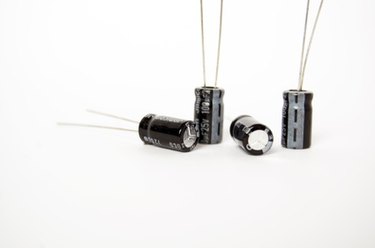
Capacitors are electronic devices designed to store electric charge. When connected to a power source, the capacitor charges up to its rated capacity. If the power source is removed, the capacitor will stay charged. When the two terminals of the capacitor are shorted, the capacitor will discharge all of its energy at once. If a resistive load is connected to the charged capacitor, the capacitor will discharge at a rate dependent on the resistance of the load. If a resistor, capacitor and a motor are connected properly, the capacitor should be able to run the motor for a short period.
Step 1
Connect the positive terminal of a small hobby motor to the first terminal of a resistor. Connect the second terminal of the resistor to the positive terminal of the capacitor. Use a resistor in the 10K-ohm to 100K-ohm range at first. The capacitor should be in the 1- to 100-farad range. The key is to choose a capacitor that can store enough charge to start the motor. You also need a resistor large enough to slow that charge down until the motor recognizes more than just a pulse.
Video of the Day
Step 2
Connect the negative terminal of the capacitor to the first terminal of a single-pole, single-throw switch. Connect the second terminal of the single-pole, single-throw switch to the negative terminal of the motor.
Step 3
Open the switch. Charge the capacitor by connecting the positive and negative terminals of a DC power source to the positive and negative terminals of the capacitor. Disconnect the power source from the capacitor once it is charged.
Step 4
Close the switch. Observe how the motor responds. Experiment with the resistor size and the capacitor size to determine how the motor responds.
Video of the Day